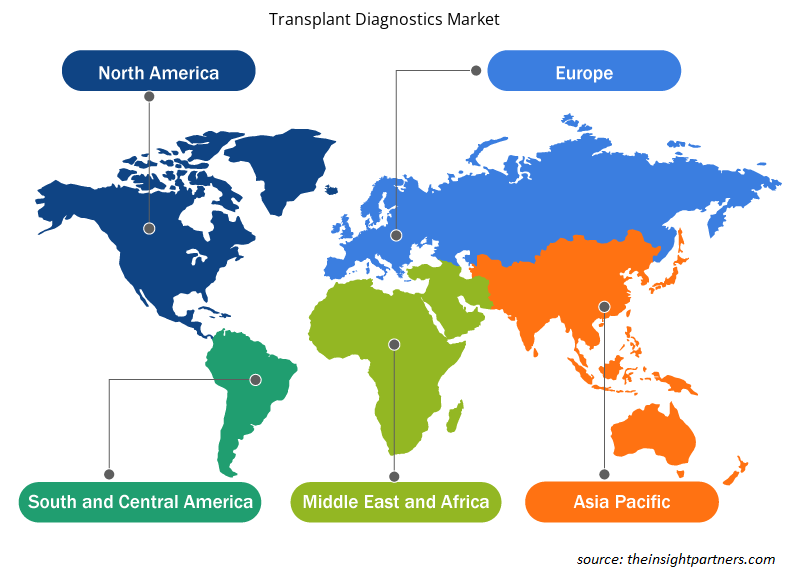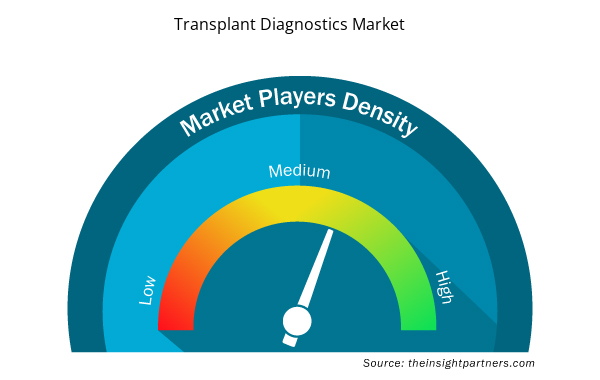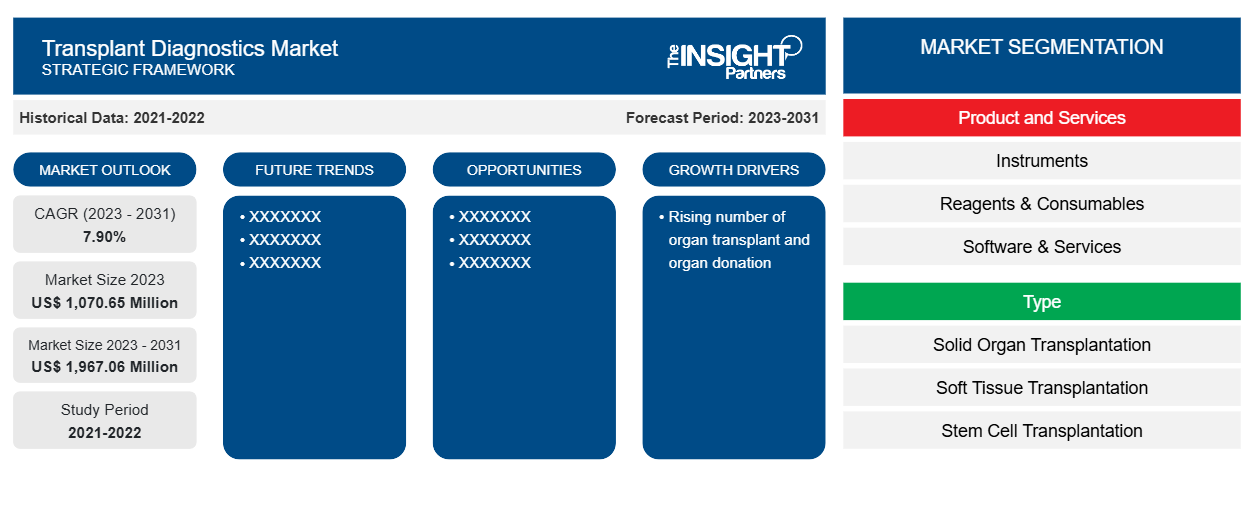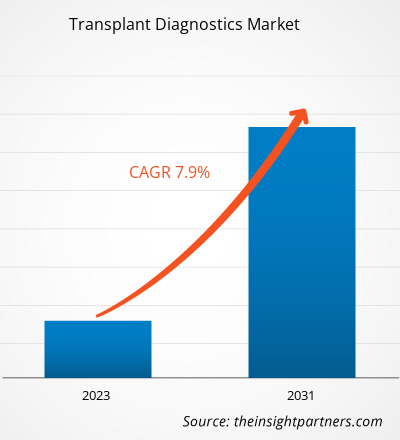من المتوقع أن يصل حجم سوق تشخيص عمليات الزرع إلى 1,967.06 مليون دولار أمريكي بحلول عام 2031 من 1,070.65 مليون دولار أمريكي في عام 2023. ومن المتوقع أن يسجل السوق معدل نمو سنوي مركب بنسبة 7.90٪ في الفترة 2023-2031. ومن المتوقع أن يؤدي العدد المتزايد من عمليات زرع الأعضاء على مستوى العالم، مثل عمليات زرع الكبد والكلى والقلب والرئة، إلى دفع الطلب على تشخيص عمليات الزرع، مما يعزز بدوره النمو الإجمالي للسوق. بالإضافة إلى ذلك، من المرجح أن يظل الانتشار المتزايد لفشل الأعضاء والأمراض المزمنة التي تتطلب إجراءات زرع الأعضاء من الاتجاهات الرئيسية لسوق تشخيص عمليات الزرع.
تحليل سوق تشخيصات زراعة الأعضاء
تعد عملية زراعة الأعضاء من أكثر العلاجات المفضلة للمرضى الذين يعانون من أمراض الكلى ويخضعون لعلاج غسيل الكلى المزمن. كما أنها خيار عملي للمرضى الذين يعانون من أمراض القلب أو الكبد. وقد تحسنت التشخيصات في جميع أنحاء العالم بشكل كبير حيث تعمل الشركات على تطوير تقنيات أفضل لتصنيف مستضدات الكريات البيضاء البشرية، ومراقبة الأجسام المضادة، والأجهزة، والبرامج. يتم استخدام هذه التكنولوجيا للتشخيص أثناء زراعة الأعضاء. يوفر التقدم في إجراءات زراعة الأعضاء فرصة كبيرة لنمو السوق.
نظرة عامة على سوق تشخيصات زراعة الأعضاء
أمريكا الشمالية هي أكبر سوق لنمو سوق تشخيص عمليات زرع الأعضاء، حيث تحتل الولايات المتحدة أكبر حصة سوقية تليها كندا. يتميز النمو في أمريكا الشمالية بالعدد المتزايد من عمليات زرع الأعضاء، وارتفاع معدل انتشار فشل الأعضاء في هذه المنطقة. وفقًا للبيانات المنشورة في United Network for Organ Sharing.org، من المقدر أن يتم إجراء ما يقرب من 46630 عملية زرع في عام 2023 في الولايات المتحدة. وبالمثل، وفقًا لـ donatelife.net في عام 2022، حققت الولايات المتحدة إنجازًا تاريخيًا، حيث أنجزت حوالي مليون عملية زرع أعضاء مقارنة بأي دولة أخرى في العالم. في عام 2023، جلب أكثر من 23000 متبرع حياة جديدة للمستفيدين وعائلاتهم. علاوة على ذلك، يوجد ما يقرب من 100000 شخص على قائمة الانتظار لعمليات زرع الأعضاء المنقذة للحياة. وبالتالي، من المرجح أن يؤدي العدد المتزايد من عمليات زرع الأعضاء في البلاد إلى دفع نمو السوق في السنوات القادمة.
قم بتخصيص هذا التقرير ليناسب متطلباتك
ستحصل على تخصيص لأي تقرير - مجانًا - بما في ذلك أجزاء من هذا التقرير، أو تحليل على مستوى الدولة، وحزمة بيانات Excel، بالإضافة إلى الاستفادة من العروض والخصومات الرائعة للشركات الناشئة والجامعات
- احصل على أهم اتجاهات السوق الرئيسية لهذا التقرير.ستتضمن هذه العينة المجانية تحليلاً للبيانات، بدءًا من اتجاهات السوق وحتى التقديرات والتوقعات.
محركات وفرص سوق تشخيص عمليات زرع الأعضاء
ارتفاع معدل الإصابة بالأمراض المزمنة التي تتطلب عمليات زرع الأعضاء يصب في صالح السوق
إن الحاجة المتزايدة إلى زراعة الأعضاء تكملها زيادة انتشار الأمراض المزمنة مثل مرض السكري وأمراض الكلى، مما يعزز سوق تشخيصات زراعة الأعضاء. على سبيل المثال، وفقًا للبيانات التي نشرتها جامعة كاليفورنيا في سان فرانسيسكو، يتأثر حوالي 750 ألف مريض في الولايات المتحدة وحوالي 2 مليون مريض على مستوى العالم بالفشل الكلوي كل عام. وبالتالي، مع فشل الأعضاء هذا، ترتفع الحاجة إلى الكلى المتبرع بها في الولايات المتحدة أيضًا بنسبة 8٪ سنويًا. تمتلك دول مثل اليابان وتايوان والمكسيك والولايات المتحدة وبلجيكا أعلى معدل انتشار للفشل الكلوي.
دمج الذكاء الاصطناعي والتعلم الآلي – فرصة في سوق تشخيص عمليات زرع الأعضاء
لقد أظهر الجمع بين الذكاء الاصطناعي وخوارزميات التعلم الآلي نتائج واعدة في سوق تشخيص عمليات زرع الأعضاء ويمكنه تحسين نتائج المرضى وتسريع تحليل البيانات وزيادة دقة التشخيص مما قد يؤدي إلى توسيع السوق. وقد ارتفع الطلب على عمليات زرع الأعضاء بسبب عوامل رئيسية مختلفة، مثل الشيخوخة السكانية، وانتشار الأمراض المزمنة المتزايد، والتقدم في الأجهزة الطبية التي تمكن مجموعة أوسع من المرضى من التأهل لعملية زرع الأعضاء.
تقرير تحليل تجزئة سوق تشخيصات زراعة الأعضاء
إن القطاعات الرئيسية التي ساهمت في اشتقاق تحليل سوق تشخيص زراعة الأعضاء هي المنتج والخدمات والنوع والتكنولوجيا والمستخدمين النهائيين.
- بناءً على المنتجات والخدمات، يتم تقسيم سوق تشخيصات زرع الأعضاء إلى الأجهزة والكواشف والمواد الاستهلاكية والبرمجيات والخدمات. الأجهزة والكواشف والمواد الاستهلاكية، والبرمجيات والخدمات. استحوذت الكواشف والمواد الاستهلاكية على أكبر حصة من السوق في عام 2023. وشهد قطاع البرمجيات والخدمات أعلى معدل نمو سنوي مركب خلال الفترة المتوقعة 2023-2031.CAGR over the forecast period 2023-2031.
- بحسب النوع، يتم تقسيم السوق إلى زراعة الأعضاء الصلبة وزراعة الأنسجة الرخوة وزراعة الخلايا الجذعية. احتل قطاع زراعة الأعضاء الصلبة الحصة الأكبر من السوق في عام 2023.
- من حيث التكنولوجيا، يتم تقسيم السوق إلى اختبارات جزيئية واختبارات غير جزيئية. ومن المتوقع أن يسجل قطاع الاختبارات الجزيئية أعلى معدل نمو سنوي مركب خلال الفترة المتوقعة.
- بحسب المستخدم النهائي، يتم تقسيم السوق إلى المستشفيات ومراكز زراعة الأعضاء، ومختبرات الأبحاث والمعاهد الأكاديمية، ومختبرات مرجعية مستقلة. احتل قطاع المستشفيات ومراكز زراعة الأعضاء الحصة الأكبر من السوق في عام 2023.
تحليل حصة سوق تشخيص عمليات زرع الأعضاء حسب المنطقة الجغرافية
ينقسم النطاق الجغرافي لتقرير سوق تشخيص عملية زرع الأعضاء بشكل أساسي إلى خمس مناطق: أمريكا الشمالية، ومنطقة آسيا والمحيط الهادئ، وأوروبا، والشرق الأوسط وأفريقيا، وأمريكا الجنوبية والوسطى.
سيطرت أمريكا الشمالية على سوق تشخيص عمليات زرع الأعضاء. يمكن أن يُعزى نمو السوق إلى انتشار متزايد لفشل الأعضاء وارتفاع عدد التبرع بالأعضاء إلى جانب إجراءات زرع الأعضاء مما يغذي نمو السوق الإقليمية. على سبيل المثال، وفقًا للبيانات التي نشرتها جمعية منظمات الحصول على الأعضاء (AOPO)، وهي منظمة غير ربحية في الولايات المتحدة، في يناير 2021، تبرع أكثر من 12500 شخص بعضو واحد أو أكثر في عام 2020، وزاد عدد الأعضاء المتبرع بها من المتبرعين المتوفين إلى أكثر من 36500 وهو ما يمثل زيادة بنسبة 2٪ تقريبًا على أساس سنوي. علاوة على ذلك، أنقذت أعضاء الموتى أكثر من 33000 حياة في السنوات السبع الماضية.
ومن ثم، فإن ارتفاع معدلات التبرع بالأعضاء يخلق الحاجة إلى زيادة اختبارات التشخيص الخاصة بزراعة الأعضاء، وبالتالي يؤدي إلى نمو السوق.
رؤى إقليمية حول سوق تشخيص عمليات زرع الأعضاء
لقد قام المحللون في Insight Partners بشرح الاتجاهات والعوامل الإقليمية المؤثرة على سوق تشخيصات زراعة الأعضاء طوال فترة التوقعات بشكل شامل. يناقش هذا القسم أيضًا قطاعات سوق تشخيصات زراعة الأعضاء والجغرافيا في جميع أنحاء أمريكا الشمالية وأوروبا ومنطقة آسيا والمحيط الهادئ والشرق الأوسط وأفريقيا وأمريكا الجنوبية والوسطى.

- احصل على البيانات الإقليمية المحددة لسوق تشخيصات زراعة الأعضاء
نطاق تقرير سوق تشخيصات زراعة الأعضاء
| سمة التقرير | تفاصيل |
|---|---|
| حجم السوق في عام 2023 | 1,070.65 مليون دولار أمريكي |
| حجم السوق بحلول عام 2031 | 1,967.06 مليون دولار أمريكي |
| معدل النمو السنوي المركب العالمي (2023 - 2031) | 7.90% |
| البيانات التاريخية | 2021-2022 |
| فترة التنبؤ | 2023-2031 |
| القطاعات المغطاة | حسب المنتج والخدمات
|
| المناطق والدول المغطاة | أمريكا الشمالية
|
| قادة السوق وملفات تعريف الشركات الرئيسية |
|
كثافة اللاعبين في السوق: فهم تأثيرها على ديناميكيات الأعمال
يشهد سوق تشخيص عمليات زرع الأعضاء نموًا سريعًا، مدفوعًا بالطلب المتزايد من جانب المستخدم النهائي بسبب عوامل مثل تفضيلات المستهلكين المتطورة والتقدم التكنولوجي والوعي المتزايد بفوائد المنتج. ومع ارتفاع الطلب، تعمل الشركات على توسيع عروضها والابتكار لتلبية احتياجات المستهلكين والاستفادة من الاتجاهات الناشئة، مما يؤدي إلى زيادة نمو السوق.
تشير كثافة اللاعبين في السوق إلى توزيع الشركات أو المؤسسات العاملة في سوق أو صناعة معينة. وهي تشير إلى عدد المنافسين (اللاعبين في السوق) الموجودين في مساحة سوق معينة نسبة إلى حجمها أو قيمتها السوقية الإجمالية.
الشركات الرئيسية العاملة في سوق تشخيص عملية زرع الأعضاء هي:
- مختبرات بايو راد،
- هولوجيك،
- شركة إيلومينا،
- ثيرمو فيشر ساينتيفيك،
- شركة كياجن
- شركة أوميكسون
إخلاء المسؤولية : الشركات المذكورة أعلاه ليست مرتبة بأي ترتيب معين.

- احصل على نظرة عامة على أهم اللاعبين الرئيسيين في سوق تشخيصات زراعة الأعضاء
أخبار سوق تشخيصات زراعة الأعضاء والتطورات الأخيرة
يتم تقييم سوق تشخيصات زراعة الأعضاء من خلال جمع البيانات النوعية والكمية بعد البحث الأولي والثانوي، والذي يتضمن منشورات الشركات المهمة وبيانات الجمعيات وقواعد البيانات. فيما يلي قائمة بالتطورات في سوق تشخيصات زراعة الأعضاء:
- أضافت شركة Thermo Fisher Scientific منتجين جديدين إلى مجموعة منتجاتها التشخيصية الخاصة بزراعة الأعضاء خلال المؤتمر السنوي للجمعية الأمريكية للتوافق النسيجي والمناعة الوراثية (ASHI). (المصدر: شركة Thermo Fisher Scientific، بيان صحفي/موقع الشركة الإلكتروني/النشرة الإخبارية، أكتوبر 2023)
- أعلنت شركة Immucor، Inc.، وهي شركة متخصصة في تشخيص عمليات نقل الدم والزراعة، عن إضافتين إلى مجموعة تشخيصات عمليات الزراعة، مما يدل على التزامها المستمر بالتطورات الجديدة في مجال التوافق النسيجي. (المصدر: Immucor، بيان صحفي/موقع الشركة على الويب/النشرة الإخبارية، مارس 2022)
- دخلت شركة Biocartis وشركة Ophiomics في تعاون للتركيز على تسويق HepatoPredict، وهو اختبار تعبير جيني تشخيصي لتحديد المرضى الذين سيستفيدون من زراعة الكبد (المصدر: Biocartis، بيان صحفي/موقع الشركة على الويب/النشرة الإخبارية، مارس 2022)
تغطية تقرير سوق تشخيصات زراعة الأعضاء والمنتجات النهائية
يقدم تقرير "حجم سوق تشخيص عملية زرع الأعضاء والتوقعات (2021-2031)" تحليلاً مفصلاً للسوق يغطي المجالات التالية:
- حجم السوق والتوقعات على المستويات العالمية والإقليمية والوطنية لجميع قطاعات السوق الرئيسية التي يغطيها النطاق
- ديناميكيات السوق مثل المحركات والقيود والفرص الرئيسية
- الاتجاهات المستقبلية الرئيسية
- تحليل مفصل لقوى PEST/Porter الخمس وSWOT
- تحليل السوق العالمي والإقليمي الذي يغطي اتجاهات السوق الرئيسية واللاعبين الرئيسيين واللوائح والتطورات الأخيرة في السوق
- تحليل المشهد الصناعي والمنافسة الذي يغطي تركيز السوق، وتحليل خريطة الحرارة، واللاعبين البارزين، والتطورات الأخيرة
- ملفات تعريف الشركة التفصيلية
- التحليل التاريخي (سنتان)، السنة الأساسية، التوقعات (7 سنوات) مع معدل النمو السنوي المركب
- تحليل PEST و SWOT
- حجم السوق والقيمة / الحجم - عالميًا وإقليميًا وقطريًا
- الصناعة والمنافسة
- مجموعة بيانات Excel



Report Coverage
Revenue forecast, Company Analysis, Industry landscape, Growth factors, and Trends

Segment Covered
This text is related
to segments covered.

Regional Scope
North America, Europe, Asia Pacific, Middle East & Africa, South & Central America

Country Scope
This text is related
to country scope.
Trends and growth analysis reports related to Life Sciences : READ MORE..
The Insight Partners performs research in 4 major stages: Data Collection & Secondary Research, Primary Research, Data Analysis and Data Triangulation & Final Review.
- Data Collection and Secondary Research:
As a market research and consulting firm operating from a decade, we have published and advised several client across the globe. First step for any study will start with an assessment of currently available data and insights from existing reports. Further, historical and current market information is collected from Investor Presentations, Annual Reports, SEC Filings, etc., and other information related to company’s performance and market positioning are gathered from Paid Databases (Factiva, Hoovers, and Reuters) and various other publications available in public domain.
Several associations trade associates, technical forums, institutes, societies and organization are accessed to gain technical as well as market related insights through their publications such as research papers, blogs and press releases related to the studies are referred to get cues about the market. Further, white papers, journals, magazines, and other news articles published in last 3 years are scrutinized and analyzed to understand the current market trends.
- Primary Research:
The primarily interview analysis comprise of data obtained from industry participants interview and answers to survey questions gathered by in-house primary team.
For primary research, interviews are conducted with industry experts/CEOs/Marketing Managers/VPs/Subject Matter Experts from both demand and supply side to get a 360-degree view of the market. The primary team conducts several interviews based on the complexity of the markets to understand the various market trends and dynamics which makes research more credible and precise.
A typical research interview fulfils the following functions:
- Provides first-hand information on the market size, market trends, growth trends, competitive landscape, and outlook
- Validates and strengthens in-house secondary research findings
- Develops the analysis team’s expertise and market understanding
Primary research involves email interactions and telephone interviews for each market, category, segment, and sub-segment across geographies. The participants who typically take part in such a process include, but are not limited to:
- Industry participants: VPs, business development managers, market intelligence managers and national sales managers
- Outside experts: Valuation experts, research analysts and key opinion leaders specializing in the electronics and semiconductor industry.
Below is the breakup of our primary respondents by company, designation, and region:

Once we receive the confirmation from primary research sources or primary respondents, we finalize the base year market estimation and forecast the data as per the macroeconomic and microeconomic factors assessed during data collection.
- Data Analysis:
Once data is validated through both secondary as well as primary respondents, we finalize the market estimations by hypothesis formulation and factor analysis at regional and country level.
- Macro-Economic Factor Analysis:
We analyse macroeconomic indicators such the gross domestic product (GDP), increase in the demand for goods and services across industries, technological advancement, regional economic growth, governmental policies, the influence of COVID-19, PEST analysis, and other aspects. This analysis aids in setting benchmarks for various nations/regions and approximating market splits. Additionally, the general trend of the aforementioned components aid in determining the market's development possibilities.
- Country Level Data:
Various factors that are especially aligned to the country are taken into account to determine the market size for a certain area and country, including the presence of vendors, such as headquarters and offices, the country's GDP, demand patterns, and industry growth. To comprehend the market dynamics for the nation, a number of growth variables, inhibitors, application areas, and current market trends are researched. The aforementioned elements aid in determining the country's overall market's growth potential.
- Company Profile:
The “Table of Contents” is formulated by listing and analyzing more than 25 - 30 companies operating in the market ecosystem across geographies. However, we profile only 10 companies as a standard practice in our syndicate reports. These 10 companies comprise leading, emerging, and regional players. Nonetheless, our analysis is not restricted to the 10 listed companies, we also analyze other companies present in the market to develop a holistic view and understand the prevailing trends. The “Company Profiles” section in the report covers key facts, business description, products & services, financial information, SWOT analysis, and key developments. The financial information presented is extracted from the annual reports and official documents of the publicly listed companies. Upon collecting the information for the sections of respective companies, we verify them via various primary sources and then compile the data in respective company profiles. The company level information helps us in deriving the base number as well as in forecasting the market size.
- Developing Base Number:
Aggregation of sales statistics (2020-2022) and macro-economic factor, and other secondary and primary research insights are utilized to arrive at base number and related market shares for 2022. The data gaps are identified in this step and relevant market data is analyzed, collected from paid primary interviews or databases. On finalizing the base year market size, forecasts are developed on the basis of macro-economic, industry and market growth factors and company level analysis.
- Data Triangulation and Final Review:
The market findings and base year market size calculations are validated from supply as well as demand side. Demand side validations are based on macro-economic factor analysis and benchmarks for respective regions and countries. In case of supply side validations, revenues of major companies are estimated (in case not available) based on industry benchmark, approximate number of employees, product portfolio, and primary interviews revenues are gathered. Further revenue from target product/service segment is assessed to avoid overshooting of market statistics. In case of heavy deviations between supply and demand side values, all thes steps are repeated to achieve synchronization.
We follow an iterative model, wherein we share our research findings with Subject Matter Experts (SME’s) and Key Opinion Leaders (KOLs) until consensus view of the market is not formulated – this model negates any drastic deviation in the opinions of experts. Only validated and universally acceptable research findings are quoted in our reports.
We have important check points that we use to validate our research findings – which we call – data triangulation, where we validate the information, we generate from secondary sources with primary interviews and then we re-validate with our internal data bases and Subject matter experts. This comprehensive model enables us to deliver high quality, reliable data in shortest possible time.


 احصل على عينة مجانية لهذا التقرير
احصل على عينة مجانية لهذا التقرير